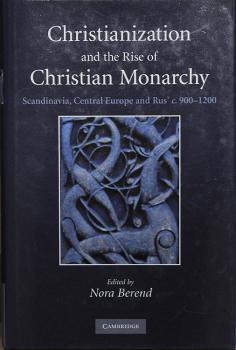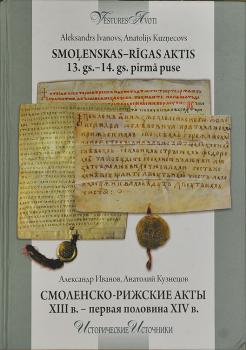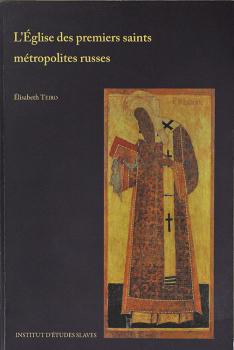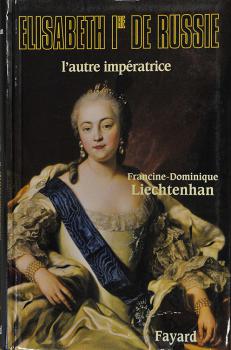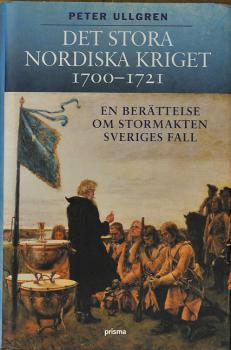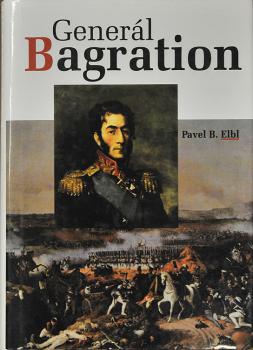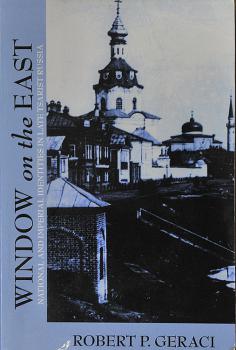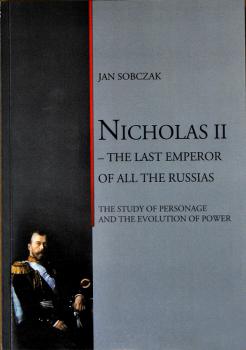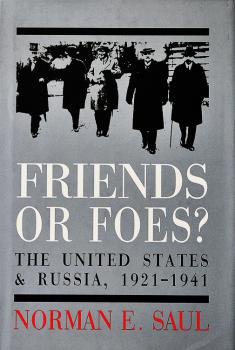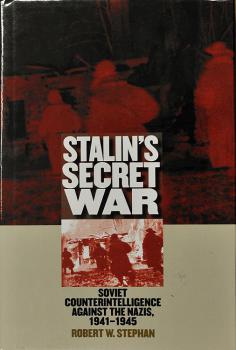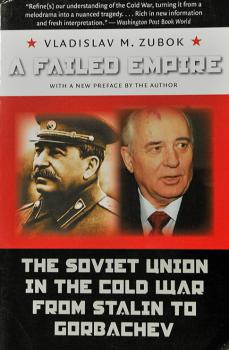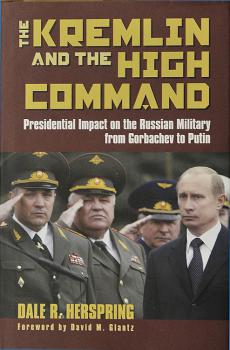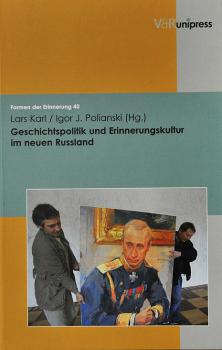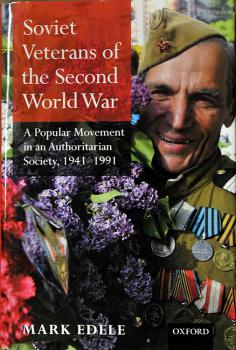In search of the Unknown Russia: "Rossica" and "Russian Abroad" in the collections of the National Library
- Books on Russian History from Ancient Times to the Present
- Books on Russian and Soviet Culture
A traditional exhibition of foreign publications on the history and culture of Russia opened on July 15, 2011 in the Main Building of the National Library of Russia (1/3, Ostrovsky Square). The exhibition featured about 170 new books received by the NLR through programms of international book exchange as well as gifts from individuals and organizations from the USA, Germany, France, Poland, Serbia, Czech Republic, Hungary, Israel and other countries.
Books on Russian History from Ancient Times to the Present
In the collection of articles Christianization and the Rise of Christian Monarchy: Scandinavia, Central Europe and Rus'c.900-1200 / Cambridge, 2009 /, leading foreign scholars explore the chief issues of the adoption of Christianity among Scandinavian and Slavic peoples. The section concerning the Christianization of Russia was written by the British researcher Jonathan Shepard, an author of numerous works on ancient and Byzantine history. The publication make it possible to trace the main characteristics of this process, that is why, it will be especially interesting for specialists in Russia's history.
In particular, we would like to draw attention to the publication of Smolensk-Riga agreements of the 13th-14th centuries, held at the Latvian State Historical Archives. These documents are an important source of ancient history, because they contain unique information about the relationship between Smolensk and Riga, Gotland and German cities during this period. The publication Smolensk-Riga Deeds in the 13th- the First Half of 14th Centuries was prepared by A.I. Ivanov, and A.M. Kuznetsov, lecturers at the Daugavpils University (Latvia) / Ivanov A., Kuznetsov A. Smolensko-rizhskie akty XIII v.- pervaja polovina XIV v. Riga. 2009 /. The book also includes an extensive study which offers a new dating and attribution of some documents, based on the paleographic, linguistic, historical and diplomatic analysis of the deeds. The study and documents have parallel Latvian and Russian texts.
Of undoubted interest to readers will the collection of articles Impostors and an Imposture in Muscovy published in Budapest in 2010 on the basis of materials of the international scientific seminar held there on May 25, 2009. Papers made at the seminar were mainly devoted to the 17th century, in other words, to the history and traits of imposture in the Grand Principality of Moscow. The authors show that, although, this phenomenon is more important for Russia than for other countries, because of Russia's historical development, imposture is still a world-historical problem and even a kind of pattern.
The American historian Marshall Poe in his book A People Born to Slavery: Russia in Early Modern European Ethnography, 1476-1748 / Poe M. A People Born to Slavery: Russia in Early Modern European Ethnography, 1476-1748. Ithaca, 2000 / traces the roots of Western European ideas about "Russian Despotism" and examines the writings of the European travelers who visited Russia in the 16th-17th centuries. In the author's opinion, foreign travelers exaggerated the degree of Russian "slavery", but their writings contain many reliable ethnographic information. He states that they "correctly concluded that the political culture of Muscovite autocracy was unlike that of European kingship".
History of the Russian Orthodox Church in the 14th-16th centuries is reflected in the book of the French scholar Elizabeth Teiro Church of the First Russian Saint Metropolitans / Teiro E. L'Église des premiers saints métropolites russes. Paris, 2009 /. The research covers the period from 1299, the time of moving the seat of Russian metropolitans from Kiev to Vladimir, to the creation of Russian Patriarchate in 1589. The author focuses on the organization of the Russian Church in this period, the institution of the metropolitans and bishops, the canonization of the higher church hierarchy. The monograph by Angelika Schmähling Stronghold of Piety - a Place of Custody. Russian Convents / Schmähling A. Hort der Frömmigkeit - Ort der Verwahrung. Russische Frauenklöster im 16.-18 Jahrhundert. Stuttgart, 2009 / continues the church theme. The author shows the contradictory functions of convents in Russia at that epoch, and indicates the distinction between the ideal of monastic rules and prosaic reality.
The eighteenth century was a time of dramatic changes in Russia's destiny. At this time the country turned into an European great power and became an empire. At the root of this revolution was Peter I. The German researcher Peter Hoffmann studies the military aspect of Peter's time in his book Peter the Great as a Military Reformer and Leader / Hoffmann P. Peter der Große als Militärreformer und Feldherr. Frankfurt am Main, 2010 /. The author uses a new way to evaluate actions of the Russian army in the Battle of Poltava and describes Peter the Great 's military legislation as having many levels. According to the author, the army in Russia was separated from civil society thanks to Peter's reforms. Swedish historian Peter Ullgren in the book The Great Northern War of 1700-1721. The Story of the Fall of the Great Swedish Power / Ullgren P. Det stora nordiska kriget 1700-1721. En berättelse om stormakten fall. Stockholm, 2008 / talks about one of the bloodiest wars of that time, which took 200 000 Swedish lives. The Great Northern War not only led to the collapse of the Swedish empire that ceased to be one of the leading political forces in Europe, but also resulted in a strengthing of Russia that was acknowledged to be the major power in the Baltic Sea. The book is noted for the fact that the author cites numerous evidence of contemporaries. This approach allows him to better capture the spirit of the era and to show the war from multiple perspectives.
The French researcher Francine Dominique Liechtenhan investigates the reign of the Peter the Great's daughter - Elizabeth. Her book titled Elizabeth I of Russia. Another Empress was published by the famous French publisher Fayard / Liechtenhan F-D. Elisabeth I- re de Russie. L'autre impépatrice. Paris, 2007 /. Using many unpublished documents, the author shows that the reign of Elizabeth was a time of many important and progressive reforms, and her foreign policy anticipated success of Russia in the next centuries, although Elizabeth has still remained in the shadow of such figures as Peter I and Catherine II.
An entire section of the exhibition is devoted to the history of Russia in the 19th century. Foreign literature on this period is diverse and covers a wide range of issues. We shall mention only some. It is known that the most important event in the history of Russia in the early 19th century was the war with Napoleonic France. The Czech historian Paul Elbl dedicated his monograph General Bagration: The Legend of the Russian Army to one of the main heroes of the Patriotic War of 1812 Bagration / Elbl P.B. Generál Bagration: Legenda ruské armády.T?ebí?, 2010 /. The British explorer Alexander Bitis conducted a study to explore Russian policy in the Middle East in the first third of the 19th century. His book is called Russia and the Eastern Question: Army, Government and Society, 1815-1833 / Oxford, 2006 /. The centerpiece of the book is analysis of the 1826-1828 Russo-Persian War, the 1828-1829 Russo-Turkish War and the Adrianople Peace Treaty of 1829.
The book by American Professor Philip Pomper Lenin's Brother: The Origins of the October Revolution / Pomper P. Lenin's Brother: The Origins of the October Revolution. New York, 2010 / examines the problems of the revolutionary movement and development of terrorism in Russia post reforms. The position of peasants during the late 19th - early 20th centuries is explored in the book by Corinne Gaudin Ruling Peasants: Village and State in Late Imperial Russia / Gaudin C. Ruling Peasants: Village and State in Late Imperial Russia. DeKalb, 2007 /. The folk culture of this period is investigated in the work by Leonid Heretz Russia on the Eve of Modernity: Popular Rreligion and Traditional Culture under the last Tsars / Heretz L. Russia on the Eve of Modernity: Popular Rreligion and Traditional Culture under the last Tsars. Cambridge, 2008 /.
The multinational society of the Russian Empire is the subject of two books published by Cornell University Press. One of them is a collection of essays Of Religion and Empire: Missions, Conversion, and Tolerance in Tsarist Russia / Of Religion and Empire: Missions, Conversion, and Tolerance in Tsarist Russia. Ithaca, 2001 /.
Another was written by professor at the University of Virginia Robert Geraci and called Window on the East: National and Imperial Identities in Late Tsarist Russia / Geraci R. Window on the East: National and Imperial Identities in Late Tsarist Russia. Ithaca, 2009 /.
A new biography of the last Russian emperor Nicholas II- The Last Emperor of All the Russians. The Study of Personage and the Evolution of Power was published by the well-known Polish historian and specialist in Russian and Polish history Jan Sobczak / Sobczak J. NicholasII - The Last Emperor of All the Russians. The Study of Personage and the Evolution of Power. Olsztyn, 2010 /.
The eight volume anthology on the 1904-5 Russian-Japanese war was issued by the British publisher Global Oriental on the centenary of the 1904-1905 Russian-Japanese War / The Russo-Japanese War, 1904-5. A collection of eight volumes. Folkestone, 2003 /. It includes books, articles, testimonies from the witnesses and people directly involved in those events as well as diplomatic and military documents. Two volumes of the anthology contain the diary of Jan Hamilton, a British lieutenant-general, in 1904-1905 military attache at the British Indian Army in Manchuria. His story covers the period from March 1904 to February 1905. Being among the Japanese troops and occupying an important position, Hamilton had the opportunity to contact the Japanese officers of the highest ranks, but that did not stop him from giving his own evaluation of all events. His diary is considered to be the most authoritative, important and well-written report of a foreign military observer of the time. Another Briton, the young lieutenant Ellis Ashmid-Bartlett was in Manchuria during the war and wrote articles from the front line for the newspaper Times. Unlike Hamilton, he spoke with the rank and file officers, was critical about the Japanese military bureaucracy, and had to rely on his own strength for collecting information. After the war, he published a voluminous book on Port Arthur / Ashmead-Bartlett E. Port Arthur. The Siege and Capitulation. London, 1906 /. The book reflects his personal perception of these events, which makes his narrative alive and authentic. Another British military journalist Charles Repington in the book The War in the Far East 1904-1905 openly took the Japanese side, and even dedicated his six hundred page work to Emperor of Japan.
In contrast, the British journalist Maurice Baring was during the war in Russia. His story positively differs from anti-Russian sentiments that prevailed in the British press, and the book is even called With the Russians in Manchuria / Baring M. With the Russians in Manchuria. London, 1905 /.
Of particular interest is a book of Japanese researcher Naoko Shimazu Japanese Society at War: Death, Memory and the Russo-Japanese War / Naoko Shimazu . Japanese Society at War: Death, Memory and the Russo-Japanese War. Cambridge, 2009 /. The author demonstrates that the Japanese society of that time was not monolithic, and in it there was disagreement about the war and the imperialist ambitions of their government. Based on the diaries and letters of ordinary soldiers, author proves decisively that the Japanese soldiers did not strive valiantly to die for their emperor, as the official propaganda tried to show, but instead, they wanted to return home to their families and were no different in this respect to soldiers of other armies. The myth about samurai heroism of the Japanese warriors and their sacrifice became especially popular after the Japanese invasion of China in 1937, a special section of the book is dedicated to the treatment of the Japanese to the Russian prisoners of war. The fact is that Japanese officials aimed to have an image of a civilized country in the world, which carries out war in keeping with the modern principles of humanism and international law. And though in reality not everything went so well, using the camp in Matsuyama as an example , the author shows that the local people treated the captive Russian soldiers friendly and also received the economic benefits from such neighbourhood.
World War I was an ordeal for our country and ended with the revolutionary explosion. Among exhibits is the book by the American researcher Laurie Stoff They Fought for the Motherland: Russia's Women Soldiers in World War I and the Revolution / Stoff L.S. They Fought for the Motherland: Russia's Women Soldiers in World War I and the Revolution. Lawrence, 2006 /. This topic has remained largely unexplored in Soviet historiography, and this book successfully fills this gap. According to by the author's observations, if in the first years of the war, women mostly worked in hospitals and served in auxiliary units, and very few of them fought on the front, in 1917, about 6,000 women took up arms and joined the then-established women's battalions, the best known of which was the first Russian women's battalion of death, led by Maria Bochkareva.
Events of the revolutionary year of 1917 and the subsequent civil war have always attracted and continue to attract the attention of foreign historians. The exhibition presents new research on this topic. The Serbian historian Sawa Zhivanov's two-volume publication Russia in 1917: from the Fall of the Autocracy to the Establishment of a Democratic Republic / ?ivanov S. Rusija 1917: od pada samodr?avnog Carstva do progla?enja demokratske republike T.1-2. Beograd, 2009 / detaily describes the development of revolutionary movements and political power in Russia in this crucial year of life. The French scholar Remy Adam in the book 1917, a Revolt of Russian Soldiers in France / Adam R. 1917, la révolte des soldats russes en France. Pantin, 2007 / talks about the impact of revolutionary events in Russia upon the Russian troops, who during the First World War, fought on the Western Front. Sarah Badcock chose the development of the Russian revolution in the province as the subject of her study, taking for example, Nizhny Novgorod and Kazan. Her book is titled Politics and the People in Revolutionary Russia: A Provincial History / Badcock S. Politics and the People in Revolutionary Russia: A Provincial History. Cambridge, 2007 /.
The American researcher Aaron Retish turned to the study of the basic category of the Russian population - the peasantry and its relations with the state for eight years. His book Russia's Peasants in Revolution and Civil War: Citizenship, Identity, and the Creation of the Soviet State, 1914-1922 / Retish A. Russia's Peasants in Revolution and Civil War: Citizenship, Identity, and the Creation of the Soviet State, 1914-1922. Cambridge,2008 / was published in the Cambridge University Press.
In a number of books depicted the situation in the Soviet state during its first decades. The lecturer of the University of Kansas (USA) David Stone in his book Hammer and Rifle: the militarization of the Soviet Union, 1926-1933 / Stone D. Hammer and Rifle: the militarization of the Soviet Union, 1926-1933. Lawrence, 2000 / studies the period of important transformations in the USSR. Along with collectivization, Stalin launched its accelerated industrialization. Military industries became the dominant sector of the national economy/ central place in which is occupied by the establishment of military industries. The author even talks about the military-industrial revolution and believes that it had far-reaching consequences, which can be compared only with the events of 1917. Due to this revolution, the Soviet Union in a short time turned into a powerful military machine, in which the army began to play the leading role, and civil society was controlled by security forces.
An initial stage in the history of Soviet diplomacy and foreign policy is examined in the book of Jonah Jacobson When the Soviet Union Entered World Politics / Jacobson J. When the Soviet Union Entered World Politics. Berkely, 1994/. The author shows how the foreign policy of Soviet Russia was closely linked to the struggle for power among the Soviet leaders and their plans to industrialize the country. Another American historian Norman Saul has focused on Soviet-American relations in the interwar period. He titled his book Friends or Foes? The United States and Russia, 1921-1941 / Saul N. Friends or Foes? The United States and Russia, 1921-1941. Lawrence, 2006 /, thus emphasizing the contradictory nature of the relationship between the two countries at this time.
The Second World War has always been and still remains a central theme of foreign historiography. The books on display reflect different aspects of this war. Chris Bellamy in his book Absolute War. Soviet Russia in the Second World War / Bellamy C. Absolute War. Soviet Russia in the Second World War. New York, 2007 /, using a large number of archival documents that had become available after the dissolution of the Soviet Union, revises many myths about the Great Patriotic War, widely spread in the Soviet historiography, in particular - the myth that Hitler's attack on the USSR was a "surprise". Available documents show that Josef Stalin did not trust Hitler, and understood that war is inevitable, though he could not determine the time of its beginning. The book includes lots of maps, plans and diagrams of battles. The author, professor of military science and doctrine at the University of Krenfildskom ( UK), served long as a correspondent for The Independent Newspaper. This experience is reflected in his manner of presentation and gives to the narrative effects of report from the scene events. As he points out, the Siege of Leningrad was a microcosm of all the ordeals which the whole Soviet people underwent during the war, a triumph of unprecedented human endurance and courage.
David Stahel in the book Operation Barbarossa and Germany's Defeat in the East / Stahel D. Operation Barbarossa and Germany's Defeat in the East. Cambridge, 2009 / analyzes the military operations of the first months of the war. According to the author, "Operation Barbarossa" was one of the largest and most expensive companies in history of warfare, and its failure was a turning point in World War II. The operation was planned as Blitzkrieg, and its success depended entirely on the armored troops, primarily on those that were part of Army Group Centre. Using previously unpublished archival documents, the author presents new approach to the summer Germany's company and pays priority attention to the panzer groups under Hoth and Guderian. From his viewpoint, the serious internal problems in Germany's panzer troops, large losses at the beginning of the war and not very successful employment of armored units in "Operation Barbarossa" predetermined the failure of the German offensive in the summer - autumn 1941.
In the book Moscow 1941: a City and its People at War, Rodric Braithwaite, British ambassador to the Soviet Union and Russia in 1988-1992, talks about the defense of Moscow in autumn 1941 / Braithwaite R. Moscow 1941: a city and its people at war. New York, 2006 /.
The author considers the Battle for Moscow as the greatest fighting of the Second World War. He writes, "...seven million people from both sides took part... The battle swirled over a territory the size of France... The Soviet Union lost more people in this one battle... than the British lost in the whole of the First World War. Their casualties in this one battle were greater than the combined casualties of the British and Americans in the whole of the Second World War." Braithwaite used a lot of archival materials that become available in recent decades. The memoirs and diaries of participants and witnesses from those events, which were cited by the author, enliven the story and allow the reader a glimpse of the defense of Moscow through the eyes of his contemporaries.
Robert Stephan, a CIA officer as well as specialist in the Russian army and intelligence security services, published the book Stalin's Secret War: Soviet Counterintelligence Against the Nazis. 1941-1945 / Stephan R. Stalin's Secret War. Soviet Counterintelligence against the Nazis, 1941-1945. Lawrence, 2004/. Based on declassified U.S. intelligence documents, captured German archives and Russian archival sources made available recently, the author tells about the massive and cruel war of the Soviet counterintelligence service against intelligence and sabotage operations by Nazi Germany. In the book, particular attention is given to such Soviet intelligence operations as "The Monastery" / 1942-1944 / and "Berezino" / 1944-1945 /, as well as an attempt to assassinate Stalin in the summer of 1944, undertaken by the German secret service agents in Operation Zeppelin. These and many other moments in the history of confrontation between the Soviet and German intelligence services found a new interpretation on the pages of a book by American author.
Post-war period in the life of our country is analyzed in the monograph of the British professor Yoram Gorlizki and memer of the State Archive of the Russian Federation Oleg Khlevniuk Cold Peace: Stalin and the Soviet Ruling Circle, 1945-1953 / Gorlizki Y. Khlevniuk O. Cold peace: Stalin and the Soviet ruling circle, 1945-1953. Oxford, 2005 /. Using newly discovered archival documents, personal correspondence, recent memoirs and interviews with former officials and family members of leaders of the country, the authors examine the complex set of relations of Stalin with his closest associates. While many researchers tend to call Stalin's behavior in these years paranoid and irrational, the authors see in the actions of the leader clear political logic and the desire to establish the Soviet Union as a new world superpower.
Vladislav Zubok, a professor at Temple University (USA), in his book A Failed Empire: The Soviet Union in the Cold War from Stalin to Gorbachev / Zubok V. A Failed Empire: the Soviet Union from Stalin to Gorbachev.Chapel Hill, 2003 / offers a Soviet perspective on the "Cold War" for the first time in foreign historiography. The author shows the birth of confrontation of the two superpowers in the days of Stalin, says about Khrushchev's contradictory attempts to improve relations with the West, Brezhnev's sincere efforts to ease international tension, and Gorbachev's firm intentions to end the "Cold War". Zubok believes that the western side exaggerated aggressiveness and pragmatism of the Soviet leadership. Newly disclosed documents reveal that the Soviet leaders themselves were prone to unreasonable fears, illusions and misconceptions about the West.
Mark Edele, Professor of the University of Western Australia, published a monograph on the little-known topic Soviet Veterans of the Second World War: A Popular Movement in an Authoritarian Society, 1941-1991 / Edele M. Soviet Veterans of the Second World War: A Popular Movement in an Authoritarian Society, 1941-1991. Oxford, 2008 /. The book shows how this large group of people began forming in the postwar period, how the veterans got recognized as a separate organization with its privileges and facilities, what prejudices from authorities they had to overcome on the way to the recognition.
A number of books explore the current state of Russia after the disintegration of the Soviet Union. The collection of articles Restoration of class society in Russia? issued by the British publishing house Ashgate / Restoration of Class Society in Russia? Ed. Nikula J. Aldershot, 2002 / present an analysis of the social structure in modern Russia. The authors examine the changes in the social structure and class formation during the 1990s, reveal the differences between Russian and Western capitalism, trace the transformation of mass consciousness and identify the distinguished characteristics of a society in transition from one socio-economic system to another.
The expert in political science, Professor of the University of Kansas Dale Herspring touches upon a very important subject of modern Russian history - the current state of the armed forces. In his book The Kremlin and the High Command: Presidential Impact on the Russian Military from Gorbachev to Putin / Herspring D. The Kremlin and the High Command: presidential impact on the Russian military from Gorbachev to Putin. Lawrence, 2006 /, the author offers a look at the evolution of Russia's armed forces during the past 25 years through the prism of relations between heads of the country and military leadership. He believes that Gorbachev and Yeltsin , by their actions, contributed to a decrease in the army's prestige and its role in society, brought the army into political and ethnic conflicts, disregarding the opinion of military people themselves. Under Putin, in his opinion, the situation has changed. On the one hand, the military have lost the former autonomy, but on the other - they have received funding for the development of the armed forces. The new government has assumed full responsibility for the decisions and has shown willingness to carry out fundamental reforms which could restore the former might of the Russian army.
Attempts of the new government to replace the old communist ideals by the use of Russian history, the revival of pre-revolutionary holidays and the establishment of new ones, the creation of new heroes and the erection of new monuments were studied by the American researcher Kathleen Smith. Her book Mythmaking in the New Russia: Politics and Memory during the Yeltsin Era / Smith K. Mythmaking in the New Russia: Politics and Memory during the Yeltsin Era. Ithaca, 2002 /. The author demonstrates how Yeltsin and the democrats who initially were skeptical of a patriotic myth-making, in times of crisis made a return to the national past in search of the ideological basis for the new regime. Similar problems are explored by the authors of the collected articles Policy in History and Culture of Memory in the new Russia / Geschichtspolitik und Erinnerungskultur im neuen Russland. Göttingen, 2009 /. "Perestroika" ("Restructuring") and "Glasnost"("Publicity") given the opportunity to Russian historians, political scientists and journalists to freely investigate the history of Russia. The former state monopoly in the interpretation of Russian and Soviet history has disappeared, and collective memory, which had recently faced pressure upon official historiography, has ceased to be uniform. One of the central places in the book is the problem of interpretation of the Second World War in post-Soviet historiography, the role of the Society "Memorial" in perpetuating the memory of Victims of Political Repression, the revival of the Cossacks, and many others.
